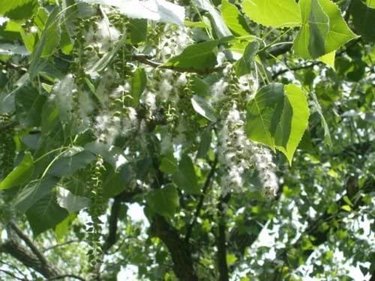What's in a name? A lot, as gardeners around the nation recognize. Every plant on the planet has at least one common name and one scientific name, itself composed of a genus and a species name. This can cause confusion, as is the case with poplars and cottonwoods.
Understand the Genus/Species Distinction
Video of the Day
Anyone who has ever pondered the difference between a rhododendron and an azalea will easily comprehend the confusion between poplars and cottonwoods. Every azalea is a rhododendron in one sense since all rhododendron and azaleas species are in the Rhododendron genus. Just so, every member of the Populus genus can be termed a poplar. This includes poplar species, cottonwood species, and aspen species.
Video of the Day
Meet the Common Cottonwood
The common or Eastern cottonwood (Populus deltoides) takes its common name from the cottony seeds it produces that drift in clouds from the rounded crowns of these impressive trees. Native to North America, they hold many records: They are one of the largest North American hardwoods and also one of the fastest-growing trees in the United States, sometimes adding as much as 6 feet per year. They can grow tall quickly, up to 200 feet tall with a 75-foot spread.
If you are seeking to distinguish the cottonwood from other poplar species, look for yellowish twigs, deeply toothed leaves that are heart-shaped but taper to a long pointed tip, and gummy end buds, not to mention the cottony snowfall of pollen. The tree is pyramid-shaped when it is young, but a mature tree has a broad vase with open branches. Do you wonder what causes the "cotton snow"? When a female tree's seed capsules split open, silky white hairs resembling cotton disperse with the seeds.
Grow a Cottonwood Tree
Cottonwood was used extensively by Native Americans. They built shelters from the timber, used the wood for heating and cooking, used the foliage as food for horses, and used various parts of the tree as medicine. In addition, this was their tree of choice for a dugout canoe. Today, cottonwoods are often planted as ornamental specimen or shade trees.
Cottonwoods thrive in U.S. Department of Agriculture plant hardiness zones 3 through 9. In the wild, they are seen growing in moist areas, like beside lakes and streams, but these trees also tolerate dry soil. Plant a cottonwood in full sun, ideally in moist, well-drained soil up to 50 feet above stream level. This native tree tolerates soil pH between 4.5 and 8.0.
